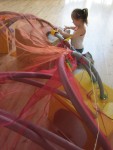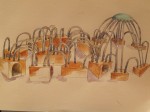“Seilmide” has been curated by visual artist Helen Barry and is supported DCC Arts Office, DCC Community & Enterprise Dep., axis: Ballymun, Wee Care Day Nurseries crèche and Graffiti Theatre Company.
My second session Workshop Two with the crèche in axis:Ballmun was once again held in the open space of their Dance Studio. ‘Seilmide’ is a collaborative process between a visual artist and early years children. It was towards the end of the session that I realized that I had not actually acted enough on my own observations during Workshop One with the children in Wee Care: – better to stand back and let the children explore it for themselves more, allow them to take the lead.
The materials in this workshop provided the children with a more individual focus rather than in Workshop One that required teamwork to build a large single structure. The session began by inviting the children to join me under a very large transparent dome shaped purple umbrella with lengths of purple see-through fabric attached. Together we moved about the space changing our pace, size and movements. We compared ourselves to different animals moving about hidden under the beautiful purple canopy. The children participated in a very playful manner but as a visual artist I felt a little uneasy or perhaps awkward at acknowledging my own skill level, thinking that an actor or storyteller could draw out more from the children at this early part of the workshop. I have also a background in dance and should draw more from my dance experience to develop the initial elements of play and exploration of our chosen theme.
After our adventures beneath our purple canopy each child was invited to take a large see-through plastic dome-shaped umbrella of their own. They walked, ran, danced, followed and spun around the large dance studio. We grouped together folding ourselves away into tiny coils protected beneath our umbrellas. Again we imitated creatures that carry their homes on their backs: seilmidí, tortoises, turtles, lobsters, crabs, armadillos and even a grainneóg (hedgehog) was compared too. We talked about what it would be like if we, too, carried our home with us.
I suggested that the children would build the umbrellas into one structure and create a larger space, warren or den that they could explore. I had also, in advance of the workshop, attached several other umbrellas together creating a singular shape of beautiful geometric patterns. Neither initially seemed to appeal to the children. I had thought that they would be curious to wriggle underneath the grouping of umbrellas. But no, they were too attached to the spaces beneath their own umbrellas. Following their interest in this I brought out a variety of dry art materials and colourful see-through fabrics and invited the children to personalize their space or ‘home’. The girls in the group seemed more involved in creating their world within the umbrella than the boys who began to explore the umbrella structure I had built.
Towards the end of Workshop Two as the two crèche workers and I were packing away everything we left the children to their own devices providing free time to play in and explore what they had made. Without any need for instruction the children created and explored what I had hoped they would create during the workshop itself. They used the umbrellas to create a den/home/base in which they played together in this world that they had created. When I joined them they invited me into their ‘home’.
When everything was packed away we sat together and talked about what we should do in Workshop Three. The children are becoming more confident in expressing their ideas and what we should build. They wanted to build Towers and when I asked who lives in towers, the children said ‘princesses live in towers’ and ‘we live in towers’ which, living in Ballymun, many of these children live have lived towers or would know someone who did.
Following Workshop Two with the crèche in axis:Ballymun I began to question the limitations of verbal language with early years children, still of whom are not familiar enough with specific terms and words. Perhaps I should use my own playful interaction and the materials to lead the workshops thereby providing direction and stimulus for what I want the workshops to explore. Therefore this would reduce the reliance on vocabulary with the younger children.
The key highlights and observations of the second ‘Seilmide’ workshop were:
- identify and follow the children’s lead more.
- find a balance between what I hope and expect the children to do whilst allowing them to explore on their own initiative.
- draw from my own background in dance to explore more playfully the theme of the workshops.
- explore further the geometric patterns from joining the umbrellas together back in the studio.
- the geometric pattern created could actually only be seen at an adults eyelevel. (explore further lights and shadows)
- allowing small breaks throughout the workshop to talk about what we are doing along the way engages the children more and allows the relationship between them and I to develop further.
Please feel free to leave a comment or share your experience of early years arts.




